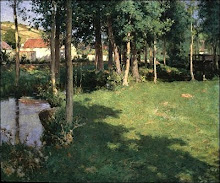It's taken me a while to warm to the work of the Swiss artist, Felix Vallotton, and I still have reservations about much of his work.
There's certainly something odd about his paintings that takes a bit of getting used to. The eccentric colours are often unpleasantly dissonant, and the compositions can be, for me, somehow dissatisfying. The strange light effects he captures can produce a sense of unease, and there is a restlessness in his scenes. He loved to paint the sudden violence of the wind, for example. But, in common with the Nabis, there is often an interesting mythological narrative element to his landscapes (see 'Pentheus' below), and always a unique vision.
The Dordogne at Carennac, 1912
Vallotton's landscapes are painted more from within - perhaps even from the world of dreams - than from the world outside. They are mostly paysages composés, landscapes patched together from elements that probably derive from plein air sketches. As a result there is a paper cut-out feel, which is not always well integrated compositionally. This is one potential disadvantage of that method of painting landscapes, though many artists have mastered it.
In his late landscapes (after 1920) he returned to a more harmonious and refined style. I particularly love those in which he celebrates a certain green - the vivid green of new grass after rain.
Vallotton painted in various genres besides landscape. He moved to France, and became associated with the Nabis. Despite being an established figure in the Parisian art scene of his day, Vallotton is not as well known today as similarly talented artists of his generation, mainly because most of his work is held in private collections, and rarely seen in public galleries.
Le Chateau de Barneville, 1910
Pentheus, 1904





.jpg)













+1900.bmp)